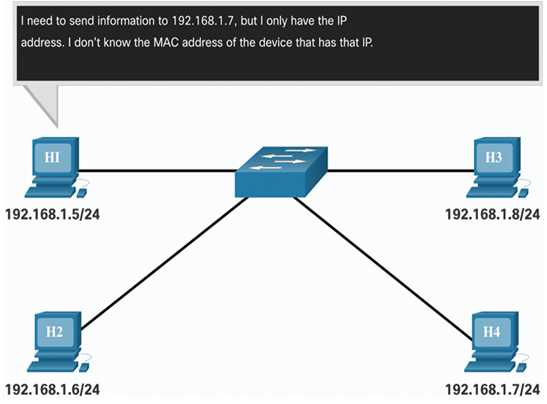Upon completion of this chapter, you will be able to answer the following questions:
• What is the purpose of ARP?
This chapter uses the following key terms. You can find the definitions in the Glossary.
Webster here again! I have another friend to introduce to you. Her name is Olcay. Olcay is an IT professional at a power company in Turkey. She is mentoring a new hire named Abay. Abay will be shadowing Olcay for the next month to become more proficient in networking in the power company. Olcay asks Abay what he knows about address resolution. Abay knows that to send a packet to another host on the same local IPv4 network, a host must know the IPv4 address and the MAC address of the destination device. A device uses ARP to determine the destination MAC address of a local device when it knows its IPv4 address.
If Abay is going to be successful at his new job, he needs to learn a little more and so do you! I suggest taking this module on Address Resolution.
This section discusses the relationship between MAC and IPv4 addresses, and the how the Address Resolution Protocol (ARP) is used to map the two addresses.
If your network is using the IPv4 communications protocol, the Address Resolution Protocol, or ARP, is what you need to map IPv4 addresses to MAC addresses. This topic explains how ARP works.
Every IP device on an Ethernet network has a unique Ethernet MAC address. When a device sends an Ethernet Layer 2 frame, it contains these two addresses:
• Destination MAC address —The Ethernet MAC address of the destination device on the same local network segment. If the destination host is on another network, then the destination address in the frame would be that of the default gateway (i.e., router).
• Source MAC address — The MAC address of the Ethernet NIC on the source host.
Figure 24-1 illustrates the problem when sending a frame to another host on the same segment on an IPv4 network.

Figure 24-1 A Host Does Not Know the MAC Address for a Destination
To send a packet to another host on the same local IPv4 network, a host must know the IPv4 address and the MAC address of the destination device. Device destination IPv4 addresses are either known or resolved by device name. However, MAC addresses must be discovered.
A device uses Address Resolution Protocol (ARP) to determine the destination MAC address of a local device when it knows its IPv4 address.
ARP provides two basic functions:
• Resolving IPv4 addresses to MAC addresses
• Maintaining a table of IPv4 to MAC address mappings
